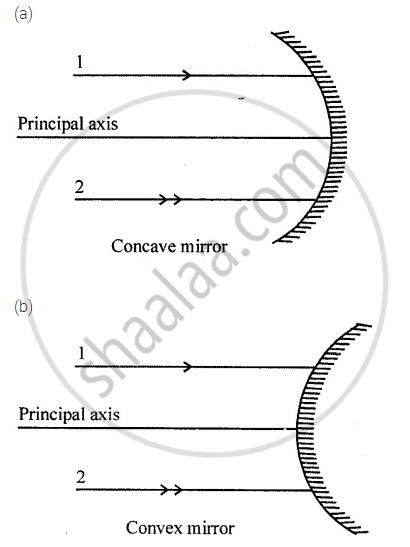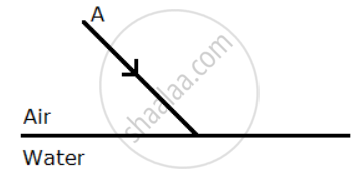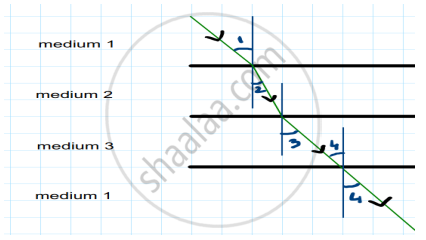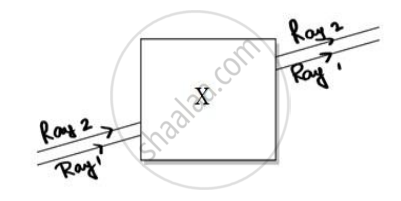Advertisements
Advertisements
प्रश्न
Write scientific reason.
The bottom of a pond appears raised.
उत्तर
- The rays of light coming from the bottom of a pond bend away from the normal as they travel from water (denser medium) to air (rarer medium).
- Hence, they appear to come from a point above the actual point from which they come. Therefore, the bottom of the pond appears raised.
APPEARS IN
संबंधित प्रश्न
| Column I | Column II | Column III | |
| 1 | Dispersion | Long-sightedness | Twinkling of stars |
| 2 | Refraction | Splitting of white light into component colours | Convex lens |
| 3 | Hypermetropia | Change in the direction of the ray of light due to change in medium | Spectrum of seven colours |
State whether the following statement is true of false:
A student says that we can see an object because light from our eyes is reflected back by the object.
Where is the image when you look at something in a mirror?
What is lateral inversion? Explain by giving a suitable example.
Write the word AMBULANCE as it would appear when reflected in a plane mirror. Why is it sometimes written in this way (as its mirror image) on the front of an ambulance?
Which type of reflection of light leads to the formation of images?
State the uses of plane mirrors.
With the help of a labelled ray-diagram, describe how a plane mirror forms an image of a point source of light placed in front of it. State the characteristics of the image formed in a plane mirror.
Explain why, though both a plane mirror and a sheet of paper reflect light but we can see the image of our face in a plane mirror but not in a sheet of paper.
If a ray of light goes form a denser medium to a rarer medium, will it bend towards the normal or away from the normal?
A ray of light goes from water into air. Will it bend towards the normal or away from the normal?
Fill in the following blank with suitable word:
Light bends when is passes from water into air. We say that it is ............
What is meant by the 'angle of incidence' and the 'angle of refraction' for a ray of light?
When a ray of light travelling in glass enters into water obliquely:
(a) it is refracted towards the normal
(b) it is not refracted at all
(c) it goes along the normal
(d) it is refracted away from the normal
What do you understand by refraction of light?
Draw a diagram showing the refraction of a light ray from water to glass. Label on it the incident ray, the angle of incidence (/), and the angle of refraction (r)
The diagram (figure) given below shows two parallel rays 1 and 2 incident on (a) a concave mirror, (b) a convex mirror. Draw the reflected rays and mark the focus by the symbol F.

A ray of light passes from medium 1 to medium 2. Which of the following quantities of the refracted ray will differ from that of the incident ray: Speed, intensity, frequency, wavelength?
A ray of light A incident from air suffers partial reflection and refraction at the boundary of water.

- Complete the diagram showing (i) the reflected ray B and (ii) the refracted ray C.
- How are the angles of incidence i and refraction r related?
A small air bubble in a glass block when seen from above appears to be raised because of ______.
Define the principal focus of a concave mirror.
Explain how the formation of a rainbow occurs.
Lights of different colours are used as signal for safety transport. From these, the wavelength of red light is _______ nm.
The incident rays and refracting rays are on opposite sides of the normal.
Write scientific reason.
The coin disappears in a vessel as it is seen from a specific location. But as soon as the water is poured into the vessel to a certain level, the coin appears.
State whether true or false. If false, correct the statement.
The angle of deviation depends on the refractive index of the glass.
The refractive index of a transparent medium is always greater than ______.
Assertion and reasoning type
- Assertion: If the refractive index of the medium is high (denser medium) the velocity of the light in that medium will be small
- Reason: Refractive index of the medium is inversely proportional to the velocity of the light
You are given water, mustard oil, glycerine and kerosene. In which of these media a ray of light incident obliquely at same angle would bend the most?

In the above diagram light is travelling through different media. It is noted by a scientist that ∠1= ∠3 = ∠4 but ∠2 < ∠1. Which of the following statement would be correct?
Noor, a young student, was trying to demonstrate some properties of light in her Science project work. She kept ‘X’ inside the box (as shown in the figure) and with the help of a laser pointer made light rays pass through the holes on one side of the box. She had a small butter-paper screen to see the spots of light being cast as they emerged.

Her friend noted the following observations from this demonstration:
- Glass is optically rarer than air.
- Air and glass allow light to pass through them with the same velocity.
- Air is optically rarer than glass.
- Speed of light through a denser medium is faster than that of a rarer medium.
- The ratio: sin of angle of incidence in the first medium to the ratio of sin of angle of refraction in the second medium, gives the refractive index of the second material with respect to the first one.
Which one of the combinations of the above statements given below is correct.
The phenomenon of light passing through the object is called ______.
The bending of light as it passes from one medium to another is called ______.
A ray of light traveling in medium 1 strikes and travels into another transparent medium 2. If the speed of light is greater in medium 1, the ray will ______.
A star appears twinkling into the sky because of the reflection of light by the atmosphere.
Match the following:
| Column I | Column II | ||
| 1. | r > 90 | a. | Light gazes at the surface of separation between the two modes. |
| 2. | r = 90 | b. | No refraction. |
| 3. | r < 90 | c. | Refracted ray away from the normal |
In refraction of light through a glass slab, the directions of the incident ray and the refracted ray are ______.
